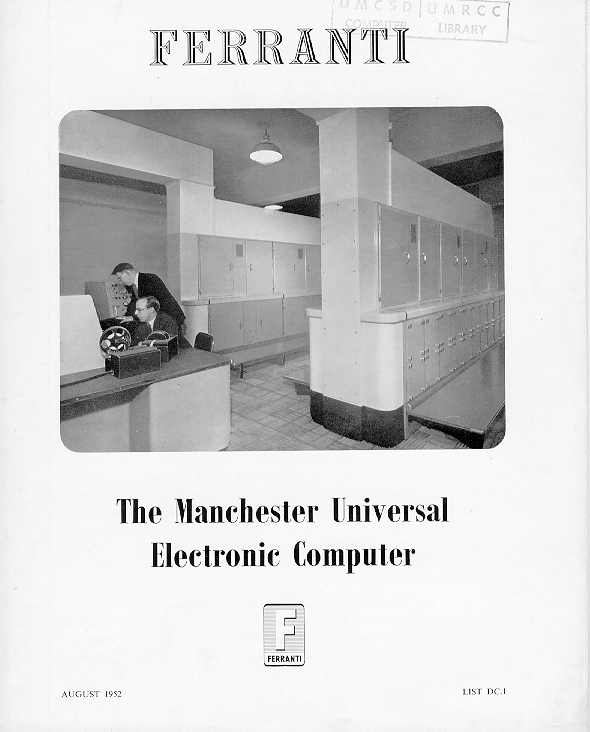

FERRANTI LTD are making electronic computers similar in design to the one developed and engineered by them and installed in Manchester University. This Manchester model incorporates ideas evolved by Professor Williams and Dr. Kilburn in the Electrical Engineering Department of the University of Manchester and has already proved itself a most versatile computing aid in many fields.
Digital computers, as the name implies, deal with numbers represented as a sequence of digits, as in the familiar desk computers. They differ in construction from "analogue" computers, such as slide rules, in which readings on a scale are made to represent numbers; they can be made to express the results of the particular computation which they are doing to as many places of decimals as are required. They can, therefore, give accurate answers to any arithmetic computation, and also handle problems in applied science involving calculations based on formulae containing continuous variables.
All machines of this type can do THREE things:
To enable them to perform these operations and to make the results available, the machines have to have instructions prepared for them in code. Mechanisms are required for "reading" these coded instructions and the numerical information required for the calculation, and for printing out the answers.
In the case of the Manchester machine, the information is presented on
punched teleprinter tape of standard pattern, which is "read" by photo-electric
cells; the answers can also be given on punched tape
or can be typed out by teleprinter. Results taken out on teleprinter tape can
be kept and fed back into the computer whenever they are required for further
calculations: it is therefore possible to deal with
larger quantities of data than can be held in the machine at one time.
The need for a rapid means of solving simultaneous equations and the
inversion of matrices is of very great importance in the field of industrial
and scientific research. Although so far we hase been
concerned only with matrices of orders up to 32 x 32 it is expected to have to
invert larger matrices for economics and other studies. The machine can deal
with symmetric matrices up to 160 x 160.
The eigenvalue problem of linear operators is of central importance for all vibration problems of physics and engineering. The vibrations of elastic structures, the flutter in aerodynamics, the stability of electric networks, the atomic and molecular vibrations of particle physics, are all diverse aspects of the same fundamental problems viz. the principal axis problem of quadratic forms.
The solution of ordinary differential equations, for open or closed boundary conditions, is a problem very well suited to the machine. Ordinary differential equations arise as the mathematical description of the continuous behaviour of physical phenomena. Those already solved by the machine have arisen in the following applications:
In many cases the tabular representation of the solutions of such equations is needed and hence the storage of a large amount of numerical information. The Manchester Machine with its large magnetic memory is particularly suitable for this type of problem. Those already solved have arisen in the following applications:
The ability of the machine to solve problems of logical rather than of
arithmetic nature is illustrated by a programme to solve chess problems (of the
mate-in-two type) and to enable the machine to play draughts with a human
opponent.
(e) TABULATION OF SPECIAL FUNCTIONS.
Tables of Laguerre polynomials and Laguerre functions (special cases of
the hypergeometric series) are being computed at present.
(f) COMMERCIAL AND INDUSTRIAL SUBJECTS
A programme for the automatic computation of survey traverse reductions is
being examined.
(h) PROGRAMMES FOR CHECKING AND FOR PROGRAMMING.
It is interesting to note that the machine can be made to assist in the diagnosis of its own faults; various programmes exist which help the maintenance engineer in the location of faulty components.
Similarly the machine can be used to simplify programming: one technique is that of "interpretive routines". These enable routines to be written in a code which will make programming as easy as possible. The machine "translates" a programme written in such a code into normal instructions before carrying it out.
From time to time ad hoc problems arise which have little connection with
real life. Two enumeration problems in pure mathematics are being coded.
The computer is serial in operation, and its basic pulse repetition frequency is 100 kc/s.; it operates with numbers of twenty or forty binary digits, i.e. six or twelve decimal digits. Some additional information is summarised below.
The possibility of making such a machine was first suggested over a hundred years ago by Charles Babbage, who was at the time Lucasian Professor of Mathematics at Cambridge. Although parts were made, and can be seen in certain museums, he was unable to complete his "engine" owing to lack of financial support and because of the inadequacy of the techniques available to him. However, from the accounts of his work which were written by Lady Lovelace (the daughter of Lord Byron), it is clear that he had a more profound understanding of the principles and possible applications of these machines than anyone else achieved until a few years ago.
The first large-scale electronic digital computers were built in the United States during the war. Since then several other machines have been built on both sides of the Atlantic.
The Ferranti machine differs in detail from all other machines, as it
makes use of two new and improved "memories" both of which were developed in
Manchester. It is the first machine of this type to be built by an engineering
firm and to be commercially available.
